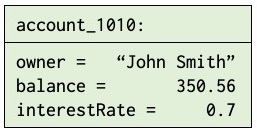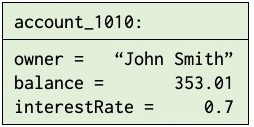The aAccount_1010 has two data-items owner, and balance that represent properties associated with a bank account. We also need to represent activities associated with bank accounts. Such activities may include calculating possible interest, and deposit and withdraw of money on an account. An activity may be represented by a method.
A method is a template for a set of computations. A method may be an attribute of an object just like a data-item. A method has a sequence of statements that when executed carry out a computation that may change the state of the object and/or compute new values from the state of the object.
In the example below, we add a method called addInterest that computes the next amount of interest for the account and add it to the balance. In addition, we have added a data-item interestRate which is the quarterly interest rate for the account. In this simple example, we thus assume that interest is added every quarter. interestRate is declared as a variable (var), since it may change over time.
account_1010: obj
owner: val "John Smith"
balance: var float
interestRate: var float
addInterest:
balance := balance + (balance * interestRate) / 100 The description of method addInterest consists of the following assignment statement:
balance := balance + (balance * interestRate) / 100The right-side expression is balance + (balance * interestRate) / 100.The variable balance denotes the current value of balance before it is updated by the assignment. The variable interestRate similarly denotes the current value of interestRate for the account.
Suppose that that balance holds the value 350.56 and interestRate holds the value 0.7. The execution of the assignment statement then takes place as follows:
- The variables
balanceandinterestRateare substituted by their current values resulting in an expression:350.56 + (350.56 * 0.7) / 100 - This expression is evaluated resulting in the value 353.01
- The value 353.01 is assigned to
balance, which thus holds the value 353.01 after execution of the assignment statement.
The addInterest-method of account_1010 may be executed by a statement of the form:
account_1010.addInterestSuch a statement is called a method invocation. As with the assignment to interestRate it must be placed in an object. The object executing the method invocation is called the invoker of the method. The object where the method is defined is called the context of the object.
In the next snapshots we have extended myFirstProgram to include an assignment of account_1010.interestRate and an invocation of account_1010.addInterest.
The first snapshot shows the state of account_1010 after the two assignments, but before the invocation account_1010.addInterest. The invoker is myFirstProgram and the context is account_1010.
myFirstProgram: obj
account_1010: obj
owner: val "John Smith"
balance: var float
account_1010.balance := 350.56
account_1010.interestRate := 0.7
...
--> account_1010.addInterest
...
The second snapshot shows the situation after the invocation of account_1010.addInterest.
myFirstProgram: obj
account_1010: obj
owner: val "John Smith"
balance: var float
account_1010.balance := 350.56
account_1010.interestRate := 0.7
...
account_1010.addInterest
--> ...
As can be seen, balance now has the value 353.01.
As mentioned, we assume that interest is added quarterly. This implies that some other component in the bank system must invoke this method every quarter. The above invocation is only to illustrate how method invocation works.
